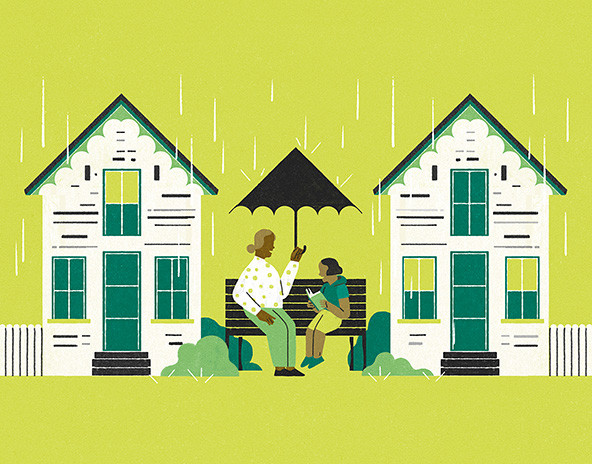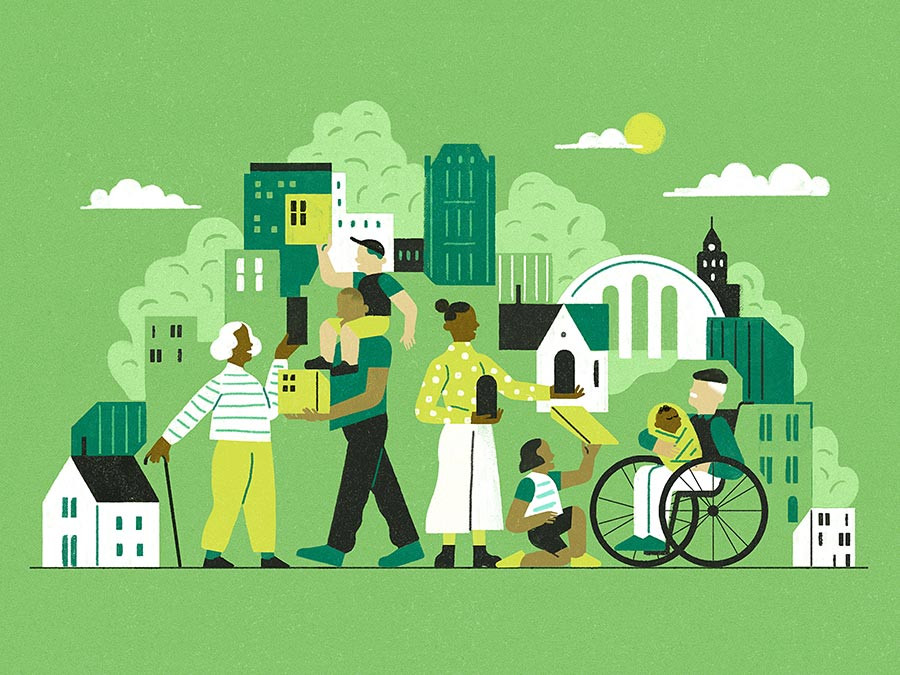 (Illustration by Gracia Lam)
(Illustration by Gracia Lam)
On any given day in the United States, about 400,000 children are in foster care, living with and cared for by people who aren’t their biological parents. Many have suffered abuse, neglect, and other serious traumas, which frequent moves and separation from siblings can compound.
While most of these children eventually return to their nuclear families, about 70,000 won’t. When a child’s biological parents have died, been incarcerated, or proved unhealthy or unsafe, grandmothers, aunts, or other relatives are often called on short notice to step in as adoptive parents or guardians. But many lack adequate housing and the emotional support they need to care for traumatized foster children, and if they’re single adoptive parents, the challenges can be overwhelming.

Meanwhile, as other essays in this series have noted, growing numbers of older Americans face financial and housing issues, as well as social isolation and a lack of purpose. Many are widowed or single, with no nearby relatives, and don’t have the physical and emotional assistance they need to thrive.
While the problems of foster children, adoptive parents, and older adults are different and difficult to solve, well-planned, “multigenerational villages” can help address them simultaneously. High-quality, affordable housing and supportive environments that intentionally bring together young and older people of diverse races, backgrounds, and ages promote deep connections among residents who help one another improve their lives.
The first intergenerational community designed to help foster children join permanent families was conceived by sociology professor Brenda Krause Eheart. Her idea was to locate families with similar challenges in close proximity so that they could share resources and experiences, and to include older adults who needed community and could support families with their time, skills, and caring. The result was Hope Meadows, opened in 1996 in Rantoul, Illinois,
Inspired by Hope Meadows, other intergenerational residential communities designed to bring together three generations have emerged around the United States. Treehouse Foundation, for example, created a community to support foster children, their families, and older adults in Easthampton, Massachusetts. Genesis serves young mothers who have left foster care without the resources of family or housing in Washington, DC. And our own effort, Bridge Meadows, helps foster children, their adoptive parents, and older adults in Oregon.
How It Works
Though these communities operate differently, they all serve either foster children or young adults who’ve experienced foster care in the past, as well as older adults. Each provides housing and support services, and aims to leverage the power of neighbors helping neighbors.
To illustrate, Bridge Meadows opened in 2011 with the aim of shifting reliance from government-funded social services to community care. Today, we run two intergenerational housing communities in the Portland area with a total of 135 people—50 children, 20 parents, and 65 elders—and we plan to open a third later this year. Residents include foster families referred by the Oregon Department of Human Services and adults over age 55 who hear about us through word of mouth or our media outreach.
Bridge Meadows provides many on-site services while also helping residents create their own support networks. Social workers act as facilitators, coaches, and trauma-informed counselors for residents, with a primary focus on helping children heal. We provide intergenerational art and other classes, weekly community dinners, and a community garden, where young and older residents can meet and strengthen ties.
Funded by a combination of government contracts, real estate development fees, rental income, and private philanthropy from foundations, individuals, and corporations, our model has made a difference in the lives of people across three generations. Ninety percent of children have maintained their new family placements with their siblings, the vast majority are attending school regularly, and 80 percent of youth report increased resilience to manage challenges. Each child who finds a permanent family and lives at Bridge Meadows also saves human services $439,000 annually in foster care payments. Meanwhile, some 85 percent of adoptive parents report that living in the community has helped them to effectively parent youth who have experienced trauma, and 80 percent of older adults report finding meaning and purpose through intergenerational relationships.
Keys to Success
Over the past 10 years, we’ve learned a lot about creating effective intergenerational communities, and hope the following insights will help others seeking to provide permanent homes and community support to children, adoptive parents, and older adults.
1. Set clear expectations. New residents sometimes expect to immediately develop close relationships with others and receive robust support. When this doesn’t happen, they sometimes experience confusion, anger, and frustration, or think they are doing something wrong. They may also underestimate their need for privacy. When parents first arrive, they need to settle in and focus on their children, helping them adjust to school and limiting the family’s involvement in community activities.
It’s important to emphasize from the start that relationships take time to develop. Prospective residents benefit from meeting with staff and current residents, receiving written materials, and discussing expectations before they decide to make a move. To support smooth transitions, Bridge Meadows sponsors Zoom and in-person conversations with prospective residents, and provides continued conversations with residents once they have moved to the community. We’re also developing a comprehensive orientation manual.
2. Use architecture and design to promote connections. Ideally, the design of intergenerational communities fosters relationships across generations while preserving private spaces for families and elders. Good design requires attention to detail, including where sidewalks cross, which direction windows face, and where communal gathering spaces are located and how big they are. Done well, these features facilitate a sense of connection and safety while reducing social isolation.
At Bridge Meadows, for example, every family and elder has their own townhouse or apartment. These connect to a shared, inner courtyard filled with trees, garden boxes, and a lawn. Most windows face the courtyard and create sight lines for adults to keep an eye on children, and townhouses feature back porches where people can gather. The architecture also includes small indoor spaces in common buildings for activities like reading or doing homework with kids, and a large community room with ample windows and natural light serves as the gathering space for adoption celebrations, community meals, classes, memorials, and other convenings.
3. Provide commitment, consistency, and connection to foster children. To thrive, foster children need commitment from adults in their lives; consistency in their new homes, neighborhoods, and schools; and strong connections with their biological or chosen families. These three “Cs” create a sense of belonging, acceptance, and security, and enable former foster children to feel cherished.
As one example, Bridge Meadows resident Ellen adopted two nephews when they were four and five, respectively. Both were born prematurely, and had learning disabilities and frequent temper tantrums that made the morning ritual a struggle for all. Ellen, who was working full time, formed a relationship with Rosie, a single woman in her 70s, who began helping prepare breakfast, and started reading and teaching the children to swim after school. Rosie’s connection and commitment to the boys, along with her daily care for them, has helped them become more trusting and helped their mother become a calmer and more-effective parent.
4. Help elders discover ways to connect with young people. Strong intergenerational bonds can be hard to form, given the norm of age-segregated housing, education, recreation, or employment.
As we mentioned above, Bridge Meadows doesn’t assign specific volunteer activities or tasks to older residents. Instead, we encourage them to participate in community gatherings, such as the weekly “Happiness Hour,” when residents eat dinner together, or to spend time outdoors in the community garden, where children help grow vegetables and fruit. At these informal gatherings, we also introduce older adults to adoptive parents and children who may share a common interest or outlook, or who we think will get along.
For example, Martin, who is in his 70s and has lived at Bridge Meadows for the past two years, met 7-year-old Luna and her adoptive mother at a community dinner. After dinner, as her mother was helping tidy up the community room, Luna invited Martin to color pictures with her, and a friendship began to blossom. He started spending time with Luna, who had been exposed to drugs in utero, resulting in neurological problems and learning disabilities. Martin helped her with schoolwork, took her to the park, and now considers her family. “This is the closest I’m going to get to being a grandfather,” he said.
5. Confront and embrace difference. Residents of intergenerational communities that address the shortcomings of foster care tend to be more diverse than residents in most urban or rural neighborhoods, in part because children of color are overrepresented in the US child welfare system. But while diversity enables people of different races, gender, sexual orientations, political parties, and geographical backgrounds to build relationships, getting there sometimes requires overcoming conflict.
At Bridge Meadows, we try to create formal and informal opportunities for residents to connect and get to know one another across differences. When conflict arises, clinicians provide guidance and support to facilitate understanding reconciliation. In 2020, for example, two young girls at Bridge Meadows proudly displayed a Black Lives Matter poster they created in the community art gallery, and an elder who didn’t agree with the poster’s message took it down. Other elders in the community informally reached out to discuss the issue with their peer who’d removed the poster and later rehung it. Bridge Meadows’ clinical staff meanwhile worked with the parents to help comfort the children, and facilitated more formal individual and small group discussions among community members to help mend relationships. Now residents are having ongoing discussions about racial equity.
Meeting the Demand
The need for more intergenerational communities devoted to foster care support far outpaces the supply. First, sites have a limited ideal bandwidth—in our experience, they function best when they serve about 100 to 125 residents. It also takes time and specialized knowledge to get one up and running, including real estate development expertise and the set-up of on-site social services that depend on a diverse group of professionals. Considerable effort also goes into managing relationships with government offices, since foster care and age-based services typically operate in disconnected silos, and funding streams to support housing and services, which are similarly disconnected.
Despite these challenges, intergenerational models are capable of scaling, and Bridge Meadows and others are innovating and exploring ways to expand nationwide. Given today’s affordable housing crisis, an aging boomer population, the continued need to support foster care children and their adoptive families, and years-long waiting lists to live in intergenerational communities, there is ample need and opportunity to develop more.
Support SSIR’s coverage of cross-sector solutions to global challenges.
Help us further the reach of innovative ideas. Donate today.
Read more stories by Sarah Feldman, Derenda Schubert, Renee Moseley & Lindsay Magnuson.

